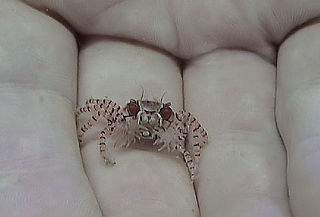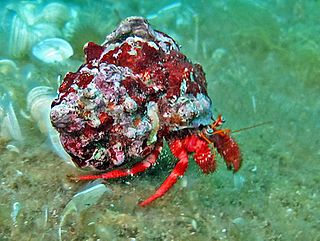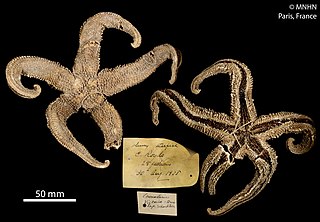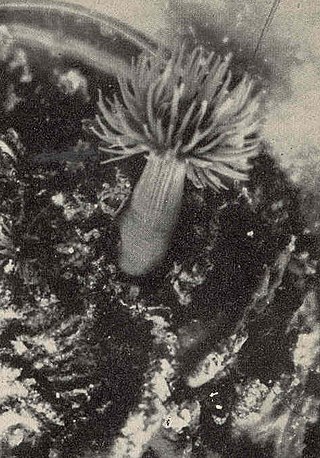
Anthozoa is a class of marine invertebrates which includes the sea anemones, stony corals and soft corals. Adult anthozoans are almost all attached to the seabed, while their larvae can disperse as part of the plankton. The basic unit of the adult is the polyp; this consists of a cylindrical column topped by a disc with a central mouth surrounded by tentacles. Sea anemones are mostly solitary, but the majority of corals are colonial, being formed by the budding of new polyps from an original, founding individual. Colonies are strengthened by calcium carbonate and other materials and take various massive, plate-like, bushy or leafy forms.

Sea anemones are a group of predatory marine invertebrates constituting the order Actiniaria. Because of their colourful appearance, they are named after the Anemone, a terrestrial flowering plant. Sea anemones are classified in the phylum Cnidaria, class Anthozoa, subclass Hexacorallia. As cnidarians, sea anemones are related to corals, jellyfish, tube-dwelling anemones, and Hydra. Unlike jellyfish, sea anemones do not have a medusa stage in their life cycle.

Spondylus americanus, the Atlantic thorny oyster, is a species of bivalve mollusc. It can be found along the Atlantic coast of North America, ranging from North Carolina to Brazil.

Metridium farcimen is a species of sea anemone in the family Metridiidae. It is commonly known as the giant plumose anemone or white-plumed anemone. It is found in the eastern Pacific Ocean from Alaska down to Catalina Island, California.

Triactis is a genus of sea anemone in the family Aliciidae. It is monotypic, having only one species – Triactis producta. This species is found in shallow waters in the Indo-Pacific where it lives on the seabed, rocks and corals. It derives much of its energy needs from the symbiotic algae it contains. It also forms a mutualistic relationship with small Lybia crabs.

Calliactis tricolor, the tricolor anemone or hitchhiking anemone, is a species of sea anemone in the family Hormathiidae. It occurs in the Caribbean Sea and the Gulf of Mexico. It can be found attached to rocks but is often attached to a living crab or mollusc or an empty shell occupied by a hermit crab.

Bartholomea annulata is a species of sea anemone in the family Aiptasiidae, commonly known as the ringed anemone or corkscrew anemone. It is one of the most common anemones found on reefs in the Caribbean Sea.

Lebrunia neglecta is a species of sea anemone in the family Aliciidae. It is found in the Caribbean Sea and Gulf of Mexico.

Actinodendron arboreum, commonly known as tree anemone or hell's fire anemone, is a species of sea anemone in the family Actinodendronidae. It is native to the Indo-Pacific where it grows at depths of down to 28 metres (92 ft). Most sea anemone species are harmless to humans, but A. arboreum is highly venomous and its sting can cause severe skin ulcers.

Phyllodiscus is a monotypic genus of sea anemones in the family Aliciidae. The only species is Phyllodiscus semoni, commonly known as the night anemone, which is native to shallow seas in the central Indo-West Pacific, such as Indonesia, the Philippines and southern Japan. It is venomous and can cause a painful, long-lasting sting to humans. It is called unbachi-isoginchaku in Japanese which translates as "wasp-sea anemone".

Lebrunia coralligens, commonly known as the hidden anemone, is a species of sea anemone in the family Aliciidae. It is found in shallow water in the Bahamas, the Caribbean, and Brazil. It lives in fissures in corals and rocks.

Anthopleura ballii, commonly known as the red speckled anemone, is a species of sea anemone in the family Actiniidae. It is found in shallow water in the northeastern Atlantic Ocean.

Dardanus arrosor, the red reef hermit or Mediterranean hermit crab, is a species of hermit crab.

Diplasterias brucei is a species of starfish in the family Asteriidae. It is found in the Pacific Ocean and Southern Ocean. It is a predator and scavenger and is unusual among starfish in that it broods its young.
Urticinopsis antarctica is a species of sea anemone in the family Actiniidae. It is found in the Southern Ocean around Antarctica.

Gonactinia is a monotypic genus of sea anemones, and G. prolifera is the only species in the genus. It is sometimes called the storey anemone and is found on either side of the northern Atlantic Ocean.

Diadumene leucolena, commonly known as the white anemone or ghost anemone, is a species of sea anemone in the family Diadumenidae. It is an inconspicuous species found in the intertidal and subtidal areas of the northeastern Atlantic Ocean, the Caribbean Sea and the northern Pacific Ocean. Diadumene, "diadem-bearer", referring to the crown of tentacles, is a female form intended to bring to mind the Diadumenos, the renowned Greek sculpture of an athlete crowning himself with the victor's ribbon diadem.

Metridium dianthus is a species of sea anemone in the family Metridiidae. It is found in the northern Atlantic Ocean and in the northeast Pacific Ocean. There is also a record from South Africa, possible resulting from an introduction.

Isotealia antarctica, the salmon anemone, is a species of sea anemone in the family Actiniidae. It is found in the southern Atlantic and Pacific Oceans and the waters around Antarctica. It is a filter feeder and opportunistic predator.

Actinostella flosculifera, the collared sand anemone, is a species of sea anemone in the family Actiniidae. It is found semi-immersed in the sediment in shallow water in the tropical and subtropical Atlantic Ocean.


















